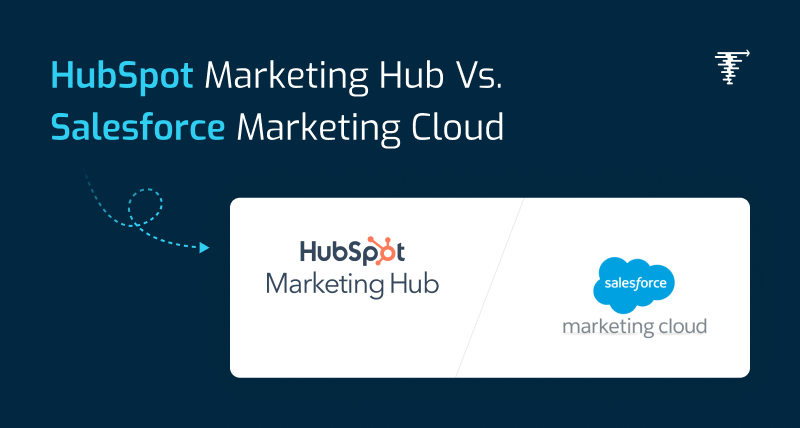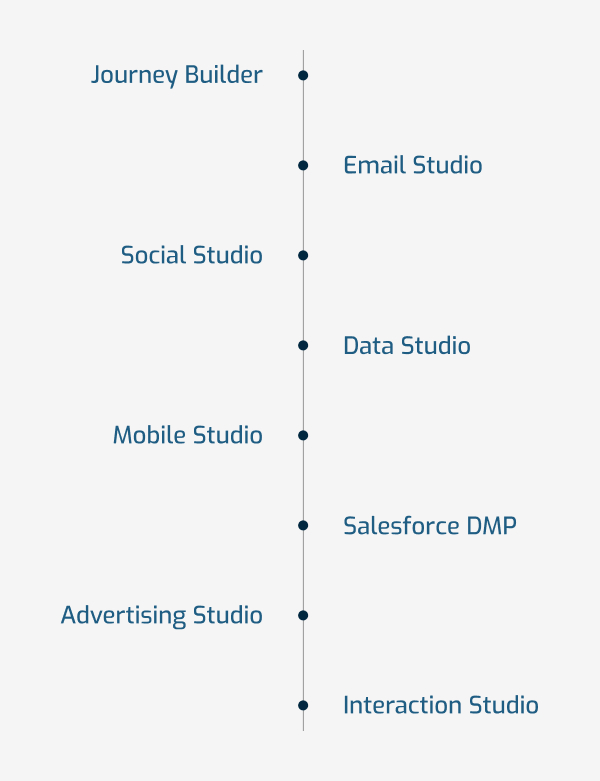

An Allied Market Research study estimates that the global digital marketing software market will be worth $181 billion by 2030. If you don’t believe these figures, look around. The number of businesses offering HubSpot vs Salesforce Marketing Cloud (SFMC) consulting services has hit the roof.
Both HubSpot and Salesforce have built some massive credentials over the years, and you can pick any without batting an eyelid. However, if you need to choose one of the two, you must make an informed decision. Certain core functions differentiating these master CRM platforms which we'll discuss later in this blog.
Let's get started by gaining a little understanding of HubSpot marketing hub and Salesforce marketing cloud.
HubSpot Marketing Hub is an integrated inbound marketing platform built to enable organisations to attract, engage, and convert leads to customers. It offers you a wide range of tools including content marketing, email marketing, automation, lead nurturing, analytics, and integration with CRM.
About 82% of marketers believe that HubSpot Marketing Hub has significantly increased their lead generation by 107% within the first six months after purchase. This staggering growth rate shows how this hub benefits businesses with its robust features.
Features of HubSpot Marketing Hub:
It is important to note that HubSpot Services also offers all the capabilities of Salesforce Marketing Cloud. This hugely popular CRM can address all your customer relationship-building needs. Let’s look at some of its standout features:
1. Segmenting Lists
When it comes to salesforce marketing cloud vs HubSpot, customer segmentation is one of the biggest strengths of the CRM platform. With marketing hub segmentation features, you can segment customers across various models, including demographics, geographic, technographic, and more. Couple that with drill-down behavioral segmentation and you can send highly customised messaging to conduct an opportune interaction that pushes a customer further into the buying funnel.
Lists are a critical use case for segmentation. You can deliver personalised emails to a list of contacts based on various criteria like the nature of content downloads (ToFu, MoFu, or BoFu), deal size, age, geography, and much more. These lists can be integrated into your email marketing automation strategy to ensure you do not miss out on sending the most relevant emails to your contacts.
A critical factor in ensuring relevance is timeliness. Your ability to improve the performance of your marketing efforts will be based on how fast you can tap into a customer's particular mood or inclination. This is where you can leverage time-based lists to know your email has a better chance of success because it's being sent at the right time.
In HubSpot’s case, these lists are powered by the CRM data, and any action in the form of clicks or views is updated so that you do not take a false step.
2. Email Marketing

Statista projects global email marketing revenues to reach $17.9 billion by 2027, with HubSpot reporting an impressive $36 ROI for every $1 spent. To succeed in email marketing, it's essential to craft compelling messages that stand out in crowded inboxes. HubSpot’s email marketing tools simplify this process, allowing users to create visually appealing emails using a drag-and-drop interface. With options for customising layouts and calls to action, users can choose from goal-based templates or browse various marketplace options.
Personalisation is key to improving open rates, and HubSpot enables this by utilising CRM data, tailoring subject lines, and content based on subscriber lifecycle stages.
Additionally, emails can be integrated into automated workflows and scheduled optimally. With real-time tracking and monitoring, you can assess campaign performance and make quick adjustments as necessary.
Related Blog: HubSpot Marketing Hub vs Sales Hub
3. HubSpot ABM (Account-Based Marketing)
According to SimilarWeb, 67% of brands are leveraging ABM, and for a good reason; this marketing strategy delivers tremendous tangible value. When we talk about marketing cloud vs hubspot, marketing hubs can be a central platform for executing and monitoring you ABM strategy.
You can utilise CRM workflow templates to target specific accounts effectively with HubSpot. By tagging accounts with properties and buyer personas, your marketing and sales teams can collaborate seamlessly on account-based marketing (ABM).
ABM thrives on personalised content for key individuals within an account—some who influence decisions and others who make them. With HubSpot, you can integrate LinkedIn ads for account-level targeting and connect LinkedIn Sales Navigator for deeper insights, helping you build meaningful relationships within target organisations.
4. Social Media Campaigns
When comparing salesforce marketing cloud vs hubspot marketing hub, make HubSpot the central hub of your social media campaigns to succeed with succesful campaigns. HubSpot’s social media management software helps you publish content to multiple social networks from one place, which means your social strategy can be a perfect subset of your marketing activities.
Features like keyword monitoring help you stay on top of all mentions, and every interaction your target audience has with your campaigns is fed into the CRM. This allows you to create social content using HubSpot AI with great context and initiate conversations that deliver improved and sustainable social media ROI.
Also, you gain insights into your campaigns performance with social reports to boost ROI for your business, identifying the qualities of a social messaging that has performed best.
5. Automated Workflows

HubSpot’s automated workflows ensure better efficiency and products across your marketing activities. You can automate your lead nurturing efforts with email drip campaigns and send them out based on specific triggers, conditions, and actions, ensuring the right emails are sent to your prospects at the right time.
More importantly, users can drill down and create a custom workflow for a particular account or contact. Let’s say you have sent a case study to a set of stakeholders within a specific organisation; in this case, you set up an automated follow-up campaign at a small interval focused on these stakeholders. This email can ask them if they want a free trial to check how your solution or product works.
Activities like lead scoring, follow-up, data management, lead sharing with sales, etc., that take up a lot of time can also be automated, thus ensuring that your marketing team has more time to strategise and execute.
6. Lead Segmentation, Tracking, and Scoring
When we discuss the hubspot marketing hub vs. salesforce marketing cloud, HubSpot can be your lead central. The dissonance between cold leads, warm leads, hot leads, MQLs, and SQLs can be managed using CRM’s lead management software. As all the data is in one place and is updated in one place, you get visibility into all leads. You can also drill down into the lead interactions that might have happened through emails, ads, etc., and score leads based on criteria suitable for your business.
All in all, you can move from a manual lead management process to an automated process wherein a set of workflows ensures that leads are scored automatically and placed in relevant buckets, shared with relevant users, and become a part of segmented lists that are the foundation of your personalised campaigns.
7. Reporting
Data is super critical for the success of your business and its many functions, like marketing, sales, and more. HubSpot is your only data repository that can deliver a powerful punch through the insightfulness and comprehensiveness of its reports. The good part about this CRM is that it can integrate with other essential apps for your business and act as a single source of truth for data from these apps. This allows you to build custom dashboards to showcase different kinds of reports by using data from multiple sources, combining numerous reports to offer a single pane of glass, and much more.
Salesforce Marketing Cloud (SFMC) is a robust marketing automation platform that enables companies to develop data-driven, personalised marketing campaigns across various channels, such as email, social media, mobile, and web. SFMC is a part of the Salesforce family and is fully integrated with Salesforce CRM, which makes it suitable for large enterprise-level marketing automation.
Read Also: HubSpot vs. monday vs. Intercom
Important Features of Salesforce Marketing Cloud:
Just like you get various tools and exceptional capabilities with marketing hub, salesforce marketing cloud offers you different components and studio.

#1. Journey Builder
The nature of your personalised messaging defines the interactions with your customers. This becomes difficult if interactions occur across multiple channels, including websites, social platforms, email, etc. The journey builder helps get visibility into their interactions and nudge customer journeys in the right direction based on specific actions such as purchases, collateral downloads, etc. This journey mapping allows you to align your customer messaging to these journeys, ensuring you deliver messaging at the right time and interaction, to get the desired outcomes.
#2. Email Studio
As the name suggests, Email Studio is all about emails. It is a marketing tool that leverages marketing intelligence and automation to engage your target audience through emails. You can take the effort out of email marketing by configuring timely sends of dynamic emails and personalising them to suit the requirements of every stage of the customer journey. It offers templates and automation benefits to improve email efficiency and response time.
This feature aims to help you make an impact with your emails by optimising the different email components and using simple drag-and-drop tools to create emails that deliver ROI and look good. Moreover, you can track the performance of your email campaigns through the Tracking Report functionality to help you make the necessary improvements.
#3. Social Studio
Statista claims, with over 4.89 billion social media users in 2023 and a figure that will reach 5.85 billion by 2027, there is no doubt your company will be using social media as a key promotional and marketing channel. Social Studio acts as your one-stop shop to maximise the value of your posts by helping you manage, schedule, create, and even monitor the performance of your posts.
This is a good feature with a business distributed across geographical locations, demanding a tailormade social media presence for that region. You can build a region-specific workspace and effectively manage the publishing of posts from these workspaces.
More importantly, it helps you create the kind of social content perfectly positioned to drive engagement and enables the creation of Facebook ads through the studio. It can act as a social media center that helps you stay on top of your social media presence.
#4. Data Studio
Data is the primary fuel that drives your customer relationship engine. With Data Studio, you can get more clarity into your existing target customer and potential customer by harnessing audience discovery tools. You can connect this feature with other data providers, such as Google Data Studio, to get a deeper insight into data. Also, you can control data access and make it available to your customers/partners securely and seamlessly. The focus here is to make data deliver ROI in many different ways. You can leverage it to understand your customers better or harness its revenue potential, sharing it appropriately with trusted partners.
#5. Mobile Studio
Pushing personalised mobile messages to your target audience is another way of constantly exploiting marketing potential. Mobile Studio helps your mobile marketing efforts and will allow you to tap into a massive $102 billion market by 2030 (Future Market Research). GroupConnect lets you send messaging to your prospects through messaging apps; MobileConnect enables you to create, send, receive, and track SMS and MMS text messages; MobilePush helps you send messages, encouraging people to use your mobile app.
#6. Salesforce DMP
You can use the Salesforce Data Management Platform (DMP) to get drill-down visibility into your customers and create and deliver personalised and outcomes-focused messaging. You also get real-time intelligence by responding to new data signals and resources, ensuring that, as a marketer, you can keep refining your strategy based on the latest information made available to you.
#7. Advertising Studio
The foundation of successful advertising rests on customer data. Advertising Studio ensures you can leverage all the data from your marketing, sales, and service cloud to make the right advertisement decisions. Also, you can ensure that you can reach your audiences on their preferred channels of advertising consumption, including Google, Instagram, LinkedIn, Twitter, and more. Precision can be brought to your advertising by aligning it with your lead generation strategy, including lead scoring, email marketing, and your sales activities; this is achieved by connecting with Pardot and Sales Cloud. Think of the Advertising Studio as ‘Advertising Central,’ which helps you make the most of your advertising budget.
#8. Interaction Studio
With Interaction Studio, you can get up-to-the-minute updates on customer experiences that result from your engagement. Visualise, track, and manage these experiences with the kind of engagement right for that moment in the customer journey. You can leverage the various features of this studio to deliver cross-channel personalisation in real time and up the ante on the relevance of customer experience across the length and breadth of the customer's journey.
Related Blog: Zoho CRM vs. Salesforce
| Feature | HubSpot Marketing Hub | Salesforce Marketing Cloud (SFMC) |
| Target Audience | Small to medium-sized businesses (SMBs) | Large enterprises |
| Pricing | More affordable, tiered pricing plans | Generally, more expensive, complex pricing based on features and usage |
| Ease of Use | User-friendly interface, easier to learn and implement | Steeper learning curve, requires more technical expertise |
| Core Strengths | Inbound marketing, content marketing, lead nurturing, and marketing automation | Multi-channel marketing automation, email marketing, data management, and advanced analytics |
| Email Marketing | Robust email marketing features with personalization and automation capabilities | Advanced email marketing features with extensive customization options and dynamic content |
| Automation | Workflows for automating marketing tasks, lead nurturing, and email campaigns | Journey Builder for creating complex customer journeys across multiple channels |
| Social Media | Integrated social media management tools for scheduling and monitoring | Social Studio for managing social media presence and engagement |
| Mobile Marketing | Basic mobile marketing features | Mobile Studio for SMS, push notifications, and in-app messaging |
| Data & Analytics | Built-in analytics and reporting dashboards | Advanced analytics with Einstein AI for predictive intelligence and data-driven insights |
| Integrations | Seamless integration with HubSpot CRM and other HubSpot tools | Integrates with Salesforce Sales Cloud and other Salesforce products, but integrations with external tools may be more complex |
| ABM (Account-Based Marketing) | Offers tools and features to support ABM strategies | Can support ABM but may require customisation and integration with other Salesforce products |
SFMC can have a steeper learning curve than HubSpot, but it depends on your team's capacity to use the platform quickly and faster. Also, think in terms of modules. You might need the entire suite of features and functionalities, so does picking and choosing from the various options on the table work for you? This is the question you must ask. Do not forget the TCO of the platform as well. Over time, the platform should be able to offer growing returns while reducing TCO when benchmarked to deliverables.
One of the ways that you can get a drill-down understanding of a CRM’s features and critical functionalities is by working with an expert marketing technology consulting partner. We encourage you to seek Transfunnel Consulting services because choosing the right platform can become complicated, considering most CRMs are similar in scope. It boils down to your needs mapped to specific platform functionalities and understanding what the functionality can tangibly deliver to make the right choice.
Get the right platform that ensures your investment's worth and elevates growth. Contact Us